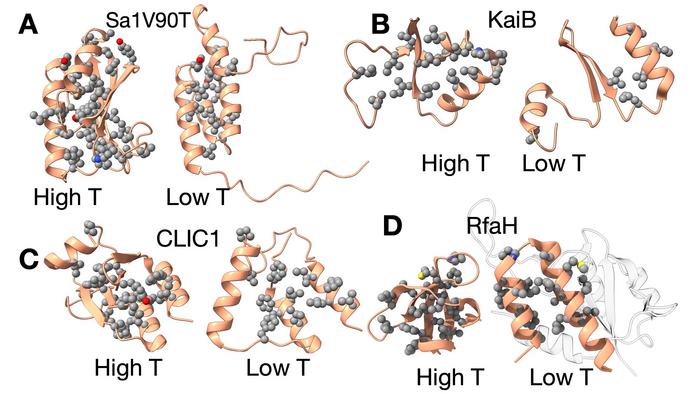Metamorphic proteins, often referred to as the “shapeshifters” of the cellular world, represent a fascinating and complex area of study within biochemistry and molecular biology. Their unique ability to transition between distinct structural states allows them to perform a wide variety of functions, crucial for the survival and adaptability of organisms ranging from humans to bacteria. Despite their importance, the mechanisms behind their transformation remain largely enigmatic. Recent inquiries into their temperature-dependent behavior have sparked new avenues of research, potentially illuminating the underlying principles that govern these proteins’ dynamic structural changes.
In the realm of biochemistry, understanding the behavior of proteins is paramount. Proteins are essential macromolecules that perform countless functions in biological systems. The ability of metamorphic proteins to adopt multiple conformations in response to environmental influences—such as temperature, pH, or oxidation—underscores their significance in maintaining cellular homeostasis. The research led by John Orban and his colleague Andy LiWang has brought to light a bold hypothesis suggesting that temperature is a critical trigger for the transitions between the various states of metamorphic proteins.
The implications of this research are profound. If the temperature dependence of metamorphic proteins is confirmed, it would denote a fundamental aspect of their functionality. Traditionally, scientists have viewed environmental changes as triggers; however, this theory proposes that the underlying equilibrium of metamorphic proteins could revolve primarily around thermal conditions. Essentially, cold temperatures could induce a less ordered state that is more conducive to transformation. This offers a paradigm shift in how researchers understand protein dynamics, emphasizing the role temperature may play in influencing structural flexibility.
Orban and LiWang’s theory is built upon previous studies that hint at the temperature-related behavior of engineered metamorphic proteins. Their research highlights that these proteins can transition back and forth between distinct structural arrangements when subjected to specific thermal conditions. This observation raises the question of whether similar mechanisms exist across various naturally occurring metamorphic proteins and could potentially be harnessed for biotechnological applications.
To test their hypothesis, Orban and LiWang performed an analysis of 26 pairs of previously studied metamorphic proteins, examining their hydrophobic contacts—regions that repel water, which are crucial for maintaining structure. Preliminary findings indicate that nearly all protein pairs exhibited significant variations in these contacts associated with temperature changes. Such differences could elucidate how lower temperatures contribute to greater structural flexibility, facilitating the shapeshifting capabilities of these proteins.
The breadth of potential applications stemming from this research cannot be overstated. A profound understanding of metamorphic proteins could revolutionize drug design and development, leading to the creation of sophisticated therapeutics capable of adapting to various physiological states. This versatility could potentially allow for the construction of “stealth” proteins that target specific cells—such as cancer cells—while remaining inactive until triggered by environmental conditions.
Moreover, the quest to identify additional metamorphic proteins is essential, as they are rare compared to monomorphic proteins, which have stable single structures. Current databases, like the Protein Data Bank, reveal a stark contrast; while around 200,000 monomorphic proteins are cataloged, fewer than 100 metamorphic proteins have been identified. The researchers’ proposed temperature-based approach could aid in uncovering new examples of metamorphic proteins, enriching the field of protein research.
The significance of their findings extends far beyond academia. As our understanding of metamorphic proteins evolves, the implications for biotechnology and medicine grow increasingly hopeful. With the potential to predict, design, and utilize metamorphic proteins effectively, scientists may soon unlock unprecedented advances in therapeutic strategies and synthetic biology applications. Envisioning future proteins that can toggle between states in response to specific environmental stimuli paints an exciting picture of what could be possible within the realms of biomedical research.
As Orban and LiWang continue to refine their ideas and investigate the complexities of protein behavior, the scientific community watches closely. Their working hypothesis, though ambitious, is bolstered by emerging experimental data. The anticipation that future research may confirm or contest their theory adds a layer of excitement to ongoing investigations in this captivating field of study.
In summary, the exploration of metamorphic proteins and their temperature-sensitive characteristics holds great promise. By further unraveling the intricacies of these proteins, researchers may not only satisfy fundamental scientific curiosities but also pave the way for transformative innovations in medicine and biotechnology. The next steps in this journey could fundamentally reshape our understanding of protein dynamics, unlocking new pathways for research and application.
Ultimately, as the study of metamorphic proteins continues to unfold, we may soon witness remarkable breakthroughs that could change the landscape of drug design, cellular engineering, and beyond, all stemming from the remarkable adaptability of proteins as influenced by their thermal environment.
Subject of Research: Metamorphic proteins and their temperature-dependent properties
Article Title: Unveiling the cold reality of metamorphic proteins
News Publication Date: March 14, 2025
Web References: DOI
References: Not applicable
Image Credits: Proceedings of the National Academy of Sciences
Keywords
Protein structure, Protein folding, Protein functions, Protein design, Drug design, Drug delivery, Biomolecular structure, Chemical structure, Chemistry, Biochemistry, Life sciences.
Tags: biochemistry research on proteinscellular adaptability and proteinscold temperatures and protein behaviorenvironmental influences on protein behaviorimplications of protein temperature dependenceJohn Orban and Andy LiWang research findingsmechanisms of protein transformationmetamorphic proteins in biochemistryprotein functionality and temperatureshapeshifting proteins in molecular biologystructural changes in proteinstemperature-dependent protein transitions





